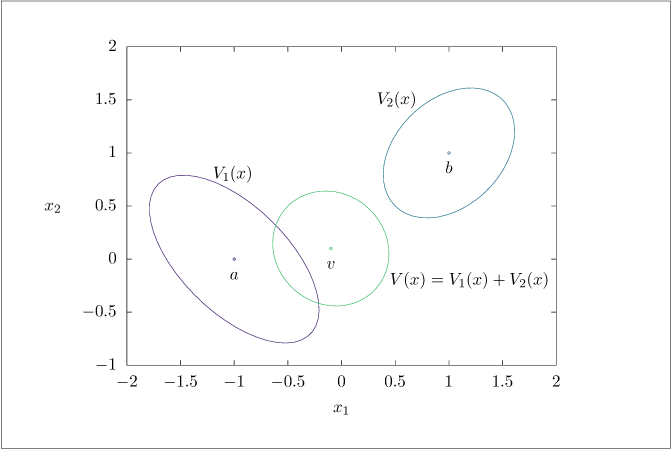Figure 1.4:
Two quadratic functions and their sum.

Code for Figure 1.4
Text of the GNU GPL.
main.m
1
2
3
4
5
6
7
8
9
10
11
12
13
14
15
16
17
18
19
20
21
22
23
24
25
26
27
28
29
30
31
32
33
34
35 | % Example sum of two quadratic functions.
a = [-1; 0];
b = [1; 1];
A = [1.25000, 0.75000; 0.75000 1.25000];
B = [1.50000, -0.50000; -0.50000, 1.50000];
% add the two quadratics
H = A + B;
h = H\(A*a + B*b);
d = -(A*a + B*b)'*h + a'*A*a + b'*B*b;
% plot resulting ellipse for combining two ellipses
% V(x) = V_1(x) + V_2(x)
level = 0.5;
npts = 50;
[xA, yA] = ellipse(A, level, npts, a);
[xB, yB] = ellipse(B, level, npts, b);
level = (2 - d/2)*2;
[xH, yH] = ellipse(H, level, npts, h);
% Make plot.
plot(xA, yA, '-r', a(1), a(2), 'or', ...
xB, yB, '-g', b(1), b(2), 'og', ...
xH, yH, '-b', h(1), h(2), 'ob');
legend('A', 'a', 'B', 'b', 'H = A + B', 'h', 'Location', 'NorthWest');
% Save data.
data = struct();
data.contours = [xA, yA, xB, yB, xH, yH];
data.centers = [a', b', h'];
gnuplotsave('nestedV.dat', data);
|
ellipse.m
1
2
3
4
5
6
7
8
9
10
11
12
13
14
15
16
17
18
19
20
21
22
23
24
25
26
27
28
29
30
31
32
33
34
35
36
37
38
39
40
41
42
43
44
45
46
47
48
49
50
51
52
53
54
55
56
57
58
59
60
61
62
63
64
65
66
67
68
69
70
71
72
73
74
75
76
77
78
79
80
81
82
83
84
85
86
87
88
89
90
91
92
93
94
95
96
97
98
99
100
101
102
103
104
105 | % Copyright (C) 2001, James B. Rawlings and John W. Eaton
%
% This program is free software; you can redistribute it and/or
% modify it under the terms of the GNU General Public License as
% published by the Free Software Foundation; either version 2, or (at
% your option) any later version.
%
% This program is distributed in the hope that it will be useful, but
% WITHOUT ANY WARRANTY; without even the implied warranty of
% MERCHANTABILITY or FITNESS FOR A PARTICULAR PURPOSE. See the GNU
% General Public License for more details.
%
% You should have received a copy of the GNU General Public License
% along with this program; see the file COPYING. If not, write to
% the Free Software Foundation, 59 Temple Place - Suite 330, Boston,
% MA 02111-1307, USA.
% [x, y, major, minor, bbox] = ellipse (amat, level, n, shift)
%
% Given a 2x2 matrix, generate ellipse data for plotting. The
% arguments N and SHIFT are optional. If N is an empty matrix, a
% default value of 100 is used.
function [x, y, major, minor, bbox] = ellipse (amat, level, n, shift)
if (nargin < 3)
n = 100;
end
if (isempty (n))
n = 100;
end
if (nargin < 4)
shift = [0, 0];
end
ss = size (shift);
if (any (ss ~= [1, 2]))
if (ss == [2, 1])
shift = shift';
else
error ('shift must be a 2-element row vector');
end
end
if (nargin > 1)
[v, l] = eig (amat / level);
dl = diag(l);
if (any (imag (dl)) || any (dl <= 0))
error ('ellipse: amat must be positive definite');
end
% Generate contour data.
a = 1 / sqrt (l(1,1));
b = 1 / sqrt (l(2,2));
t = linspace (0, 2*pi, n)';
xt = a * cos (t);
yt = b * sin (t);
% Rotate the contours.
ra = atan2 (v(2,1), v(1,1));
cos_ra = cos (ra);
sin_ra = sin (ra);
x = xt * cos_ra - yt * sin_ra + shift(1);
y = xt * sin_ra + yt * cos_ra + shift(2);
% Endpoints of the major and minor axes.
minor = (v * diag ([a, b]))';
major = minor;
major(2,:) = -major(1,:);
minor(1,:) = -minor(2,:);
t = [1; 1] * shift;
major = major + t;
minor = minor + t;
% Bounding box for the ellipse using magic formula.
ainv = inv (amat);
xbox = sqrt (level * ainv(1,1));
ybox = sqrt (level * ainv(2,2));
bbox = [xbox ybox; xbox -ybox; -xbox -ybox; -xbox ybox; xbox ybox];
t = [1; 1; 1; 1; 1] * shift;
bbox = bbox + t;
else
error ('usage: ellipse (amat, level, n, shift)');
end
% end%function
|
